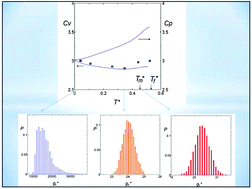Molecular dynamics study of a one component soft-core system: thermodynamic properties in the crystalline state
Abstract
In the present work, molecular dynamics (MD) simulations have been performed to study thermal properties of crystals in a one component soft-core system. The system was examined along the phase-diagram using the compressibility factor, ![[P with combining tilde]](https://www.rsc.org/images/entities/i_char_0050_0303.gif) (T*) ≡ PV/NkBT plotted against the reduced density ρ* (or reduced temperature, T*). The specific heat,
(T*) ≡ PV/NkBT plotted against the reduced density ρ* (or reduced temperature, T*). The specific heat, ![[P with combining tilde]](https://www.rsc.org/images/entities/i_char_0050_0303.gif) (ρ*) and also as the function of the reduced potential energy, U*. These
(ρ*) and also as the function of the reduced potential energy, U*. These  and dynamical compressibility factor (PV/NkBT)t are also examined and three T* regions of thermal behaviors are characterized. In the diagram, the glass transition by cooling or compression can be treated on the same basis. Results of the present work will be helpful for a better understanding of the changes in the specific heat during the glass transition in the future works.
and dynamical compressibility factor (PV/NkBT)t are also examined and three T* regions of thermal behaviors are characterized. In the diagram, the glass transition by cooling or compression can be treated on the same basis. Results of the present work will be helpful for a better understanding of the changes in the specific heat during the glass transition in the future works.


 Please wait while we load your content...
Please wait while we load your content...